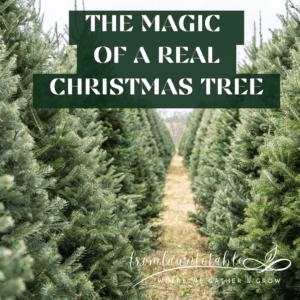
Every Christmas season growing up, we visited the Lion’s Club Christmas tree lot at Foodland, our local grocery store. A fire burned in a metal drum to warm the attendants, and the smell of pine and smoke filled the air. When choosing our tree, we considered the size (not too tall, not too fat), the fullness, and whether we wanted short, sturdy needles, or long, elegant needles. I preferred the long needles due to aesthetics. Mom preferred the short needles for practical reasons, the long needles more likely to fall out leaving a blanket of needles requiring more cleanup.
One year, our new kitten Snowball climbed the tree. Our poor tree couldn’t bear the weight and fell over, sadly scattering pine needles and broken ornaments across the floor. Another year, money was tight. We forewant the Lion’s Club trees in favor of chopping down our own on my grandparent’s property. A coniferous tree, who knows what kind. It was short, wide, and full of space between the branches. It reminded me of Charlie Brown’s Christmas tree, and I loved that thing as much as Charlie Brown grew to love his tree.
The worst part of Christmas was throwing out the Christmas tree. As an idealistic teenager, I couldn’t fathom how we allowed this tree to sacrifice its life for our short season, and desperately wanted to find a way to replant our trees. The best part of being an adult? The ability to make our own Christmas traditions.
Should I replant my real Christmas tree? And, if so, what do I need to know?
The type of tree is important. The best types of Christmas trees to replant are those that are hardy and able to withstand the stresses of transplanting. Some good options include:
- Fraser fir: Fraser firs are a popular choice for Christmas trees and are known for their good needle retention and pleasant aroma. They are native to the Appalachian Mountains and are hardy in USDA zones 4-7.
- Douglas fir: Douglas firs are another popular choice for Christmas trees and are known for their strong branches and good needle retention. They are native to the Pacific Northwest and are hardy in USDA zones 4-7.
- Blue spruce: Blue spruces are a popular choice for Christmas trees and are known for their distinctive blue-gray needles and pyramid-shaped form. They are native to the Rocky Mountains and are hardy in USDA zones 2-7.
- White spruce: White spruces are another popular choice for Christmas trees and are known for their good needle retention and pleasant aroma. They are native to the eastern United States and are hardy in USDA zones 2-6.
- Scotch pine: Scotch pines are a popular choice for Christmas trees and are known for their good needle retention and attractive bark. They are native to Europe and are hardy in USDA zones 2-7.
No matter which variety, choose a tree that is healthy and has a good root system, as trees with weak or damaged roots may not survive the transplant.
Christmas is over, and now I’m ready to transplant my tree. What do I need to do now?
- Choose the right location: Consider the size and mature height of the tree, as well as its light and moisture requirements. Choose a location that meets these needs and has well-draining soil.
- Prepare the soil: Before planting the tree, loosen the soil in the planting area and mix in compost or well-rotted manure to improve its fertility and structure.
- Plant the tree properly: When planting the tree, be sure to dig a hole that is at least twice as wide as the root ball of the tree. Place the tree in the hole so that the roots are spread out and the tree is planted at the same depth it was in the pot or container.
- Water regularly: After planting the tree, water it deeply to help it get established. Keep the soil moist, but be sure to allow the soil to dry out between waterings to prevent root rot.
- Fertilize lightly: Use a balanced fertilizer and apply it according to the package instructions. Avoid using too much fertilizer, as this can lead to weak, leggy growth.
By following these tips, we can save a tree and create a new Christmas tradition for our families.